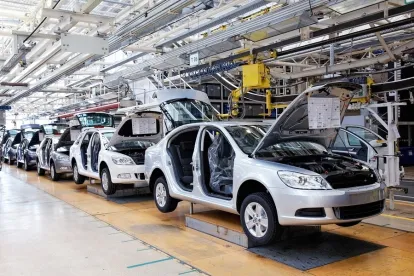The Center for Automotive Research (CAR)’s annual Management Briefing Seminars kicked off on Monday in Traverse City, Michigan. Tuesday’s sessions included a detailed update and outlook on “The North American Market: Sales and Production Footprint,” presented by a panel of leading automotive forecasters, analysts and suppliers. The subtitle to this otherwise sterile title could have been “The Sky Is Not Falling,” a theme that was echoed by several of the presenters. And, while the current volumes remain healthy if not plateaued, all of the speakers stressed that the companies who will have success in the automotive industry over the next 15-20 years will be the ones who can best make the walk from today’s market to the 2030+ market that features more full (L5) autonomy and electrification. In other words: success will depend on the ability to live in today and tomorrow’s worlds at the same time.
 The panelists included moderator Bernard Swiecki, Director – Automotive Communities Partnership (ACP) and Senior Automotive Analyst, CAR; Jeff Schuster, Senior Vice President of Global Forecasting, LMC Automotive; Michael Robinet, Managing Director, Automotive Advisory Services, IHS Markit; Colin Langan, Director, General Industrials, UBS; Mike A. Jackson, Executive Director, Strategy and Research, Original Equipment Suppliers Association (OESA); Eric Fedewa, Senior Manager, Vehicle Group, Global Market Intelligence, Eaton; and Denise Carlson, Vice President, NAPIC Planning and NAPIC Material Engineering Groups, DENSO International America.
The panelists included moderator Bernard Swiecki, Director – Automotive Communities Partnership (ACP) and Senior Automotive Analyst, CAR; Jeff Schuster, Senior Vice President of Global Forecasting, LMC Automotive; Michael Robinet, Managing Director, Automotive Advisory Services, IHS Markit; Colin Langan, Director, General Industrials, UBS; Mike A. Jackson, Executive Director, Strategy and Research, Original Equipment Suppliers Association (OESA); Eric Fedewa, Senior Manager, Vehicle Group, Global Market Intelligence, Eaton; and Denise Carlson, Vice President, NAPIC Planning and NAPIC Material Engineering Groups, DENSO International America.
Jeff Schuster’s presentation, entitled “The Quandary of Two Automotive Markets: Today and Tomorrow,” provided an overview of the leading global automotive trends. He noted that the global light vehicle market is expected to grow 2% in 2017 (to 95 million units) and 1.7% in 2018, which growth is expected to continue at about 2% annually through the 2020 forecast period. He noted that most of this growth is coming from outside the U.S., which is down 2% year to date, and that about 40% of the growth over the forecast period will come from China. From a North America production standpoint, he forecasts 17.7 million units in 2017, down modestly (.6%) from 17.8 million units in 2016. Global capacity utilization in the industry was 69.6% in 2016 (94% in the U.S.) and is expected to be 72.2% in 2021 (83% in the U.S.). Based on this disparity, he predicted that IF there is any new plant investment in the U.S., it will result in plant closures elsewhere. SUVs will remain a key driver in the automotive industry, reaching 35% of the global market (45% in the U.S.) by 2021. Overall, we are seeing “a reasonably positive story” according to Mr. Schuster. He then discussed the provocative question: “Will the Disrupters Get Disrupted By Reality?” This reality includes a global car park that is expected to reach 1.5 billion by 2022, and the “Wheel of Challenge” (which he also dubbed the “Wheel of Delay”) facing the adoption of full autonomy. Over the long term, Mr. Schuster forecasts 5-10 million autonomous vehicles being deployed annually by 2030-2035, compared to global production of about 120 million vehicles in the same forecast period.
Michael Robinet of IHS themed his presentation “The Focus on the Journey,” with the eventual destination being fully autonomous vehicles (L5) with electrification. In Mr. Robinet’s view, the winners and losers will define themselves by how well they are able to make that journey. He described the L5/Electrification focus now as the “shiny penny” that suppliers are using to stand out and differentiate themselves, even as most of today’s focus is on meeting build schedules and launches. IHS forecasts a 17.1 million sales volume in North America in 2017, with a production outlook of 17.4 million vehicles. Over the forecast period, IHS forecasts that the “Detroit 3” will lose some production volume in the Midwest and Ontario, with the Southeastern U.S. holding its own and Mexico growing. Mr. Robinet highlighted that SUV’s will continue to lead the way in N.A. production, with a quarterly gap of 700,000 units next year vs. passenger vehicles (which numbers were roughly equivalent as recently as 2014). He further predicted that 95% global vehicles will still be powered by an internal combustion engine (ICE) by 2025, with carmakers having to design powertrains to the “highest common denominator” of the various regulatory bodies (EPA/NHTSA/CARB/EU/China). He predicted that the adoption of electric vehicles will be faster in China and Europe vs. North America, based on some of the regulatory and environmental imperatives that will be in play. He then hit the audience with his “2 by 4” slide: the number of new engine launches after 2020 will fall off the shelf, as OEMs ride out the present investments they are making and carefully (with their capital) transition to the future electrified state.
Colin Langan of UBS then proceeded to discuss his current sales forecast of 17 million units in North America for 2017, noting that “we are in a plateau environment.” He blunted two frequently heard concerns regarding the current market that many believe signal a pending downturn: deteriorating auto credit and used car pricing concerns, noting that the current statistics are not far off historical averages and do not appear to be having a significant impact on the market. He then discussed an interesting recent UBS project involving a “tear down” of a Chevy Bolt EV. Based on UBS’ analysis, the current gap in cost between an EV and ICE-powered car is around $10,000, with that gap expected to drop to $3,000-4,000 by 2025. He also noted that the Bolt currently makes about $3,000 per vehicle on a variable cost basis (not accounting for all the development costs), while Tesla loses about $2,800 per vehicle at 75,000 units produced and even at scale (2 million units) will just reach breakeven EBITDA. He then went on to note that an MIT/Singapore study had found that over the long term there will be a 60% decline in the size of the vehicle fleet resulting from the shift to autonomous vehicles. He believes this number will be greatly offset by more people driving, a decrease in costs as demand rises, and an expected 30% increase in miles driven, which will require faster vehicle replacement. Finally, Mr. Langan focused on the underappreciated impact of “Big Data” and its related economic opportunities for carmakers and other industry players. He highlighted the possibilities of a much more seamless sales and service experience, resulting in lower vehicle inventories and less marketing costs for OEMs. He noted the attractive margin opportunities presented by Big Data, which will be the focus not only of traditional OEMs and suppliers but also for all of the technology companies that are vying for prominence in the vehicle cockpit.
Mike Jackson of OESA went on to review the current North American market, echoing a 2% YTD drop (with light trucks up 5% and passenger cars down 11.5%). According to a recent Supplier Barometer survey by OESA, the #1 threat that suppliers currently perceive is the poor sale of vehicles on the programs that they supply, highlighting the importance of a good product mix. And, like others, he stressed that “[SUVs and CUVs] are carrying the industry.” Finally, he noted that the talent skills gap is an ongoing and vexing issue that the industry is facing, projecting a 63% skills gap that the OESA and other industry, governmental and educational stakeholders are taking aim at to reduce.
Eric Fedewa of Eaton and Denise Carlson of Denso added their industry-focused perspectives and product plans, including a review of factors (both economic, environmental and safety) that drive their capital deployment and product planning decisions.
In the Q&A session, the panelists were asked whether the industry is better prepared for the next downturn, and the panel answered “yes” based on better discipline in production, supplier caution in adding capacity and the expected less severe projected magnitude of any downturn. One question focused on the flagging stock prices of the Detroit 3 OEMs, and Mr. Langan cited (1) the general belief that the industry is “deep” in the current cycle in North America, and (2) the perceived uncertainty that these OEMs will successfully make the transition to electrification (despite examples like the Bolt) and autonomy. Finally, most panelists concurred that Mexico will continue to play an important role and did not foresee China making a serious dent in that nearshore advantage in supplying the North American market (despite developments like Ford importing some Focus production from China).
All in all, the overall impression from the panel was that the most successful automotive players will be those who can multitask: those who can successfully meet the current production needs and product launches in the market, while continuing to build capabilities toward the future world of full autonomy and electrification. So, you could say this is one case where maintaining a split personality will be a good thing!




 />i
/>i
